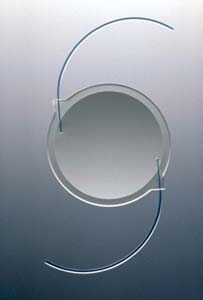What are Monofocal IOLs?
The most commonly used intraocular lens implants placed at the time of laser cataract surgery are spherical lenses with varying powers to attempt to match a patient’s choice of their primary focal length. With some degree of precision, the implants can help patients with spherical eyes develop a suitable focal distance.
These lenses have been used since 1949 with various modifications over six decades. This monovisual approach is a time-tested solution and still considered the standard when it comes to addressing long-distance vision.
It is important to consult closely with your doctor to see what type of intraocular lens implant is the right choice for you.

Who is a candidate for monofocal IOL?
Up until 2003, the only available intraocular lens to replace the natural cataract-clouded lens was a monofocal IOL. These lenses provide vision at a single range, whether distance, intermediate or near. The patient receiving a monofocal IOL will need glasses to correct for the other distance(s). For instance, most monofocal IOLs are set for distance vision, with the patient using reading glasses for up-close vision such as reading.
In 2003, multifocal IOLs were introduced. Unlike monofocal lenses, multifocal IOLs provide good vision across the range of distance. While not crystal clear, 20/20 in all fields, multifocal IOLs typically allow patients to drop the need for eyeglasses in most situations.
But some patients still opt to have monofocal IOLs placed in cataract surgery. Here are a few reasons you could be a good candidate for monofocal IOLs:
- You require crystal clear vision for your job, such as an airline pilot.
- You are accustomed to using reading glasses due to presbyopia, the condition where our eyes have more and more trouble focusing for up-close viewing after we pass our 40th birthday. If you are highly presbyopic, having crystal clear distance vision and using reading glasses for up-close vision would be easily adapted to.
- You don’t want to have any issues with glare and halos around lights at night, which can be a side effect with multifocal IOLs (although it decreases with time).
- You want Medicare or your insurance to fully pay for your IOLs. This is only the case with monofocal IOLs at this time.
What are the benefits of monofocal IOL?
- These IOLs provide the sharpest vision at the field depth you choose, typically distance vision.
- Patients with monofocal IOLs don’t typically experience halos or glare around lights at night, as can be experienced with multifocal IOLs.
- Both Medicare and private insurance providers usually cover the entire cost of monofocal cataract surgery. When a person chooses multifocal lenses, they must pay an additional fee.
- Toric monofocal IOLs can now correct astigmatism.
What are the disadvantages of monofocal IOL?
- With monofocal IOLs the patient needs to choose the type of vision they want to be crystal clear, whether that is the distance, intermediate, or up-close vision. That will be the depth of focus that will be sharp; correcting for the other distance or distances will require the patient to wear glasses.
- Patients with monofocal lenses will continue to need glasses at least some of the time. With multifocal IOLs, most patients can stop wearing glasses for most, if not all, vision.
- Monofocal IOLs cannot correct for presbyopia (unless the patient chooses up-close vision for their lenses) whereas different multifocal IOLs can now correct for presbyopia.
How are monofocal IOLs implanted in your eyes?
Once a lens has clouded with a cataract, the change is permanent. If left untreated, the eye will become cloudier and cloudier, eventually leading to blindness. Fortunately, cataract surgery is safe, incredibly effective, and only involves minimal discomfort.
These procedures are the same no matter what type of intraocular lens the patient chooses. There is a slight adjustment when toric IOLs are placed, as the IOL needs to be rotated to the correct position once placed, but the procedure is still the same.
At the Eye Care Institute, we perform minimally invasive, small-incision, no-stitch cataract surgery called phacoemulsification (phaco) surgery. We use a femtosecond laser for greater precision and accuracy, and to remove the need for a surgical blade. Here’s how we perform the procedure.
Our system first renders a 3D image of the eye for guidance. The system’s femtosecond laser then creates the corneal incision and removes the anterior capsule of the lens to gain access to the cataract lens. This incision is very small. Next, the laser makes some cuts in the cataract-clouded lens. A probe then delivers high-frequency ultrasound energy to break up the cloudy lens, immediately using suction to gently remove the small lens pieces from the eye. The previous scoring by the laser reduces the amount of ultrasound energy needed to break up the cataract lens. We may also use the laser at this point to create peripheral corneal incisions to reduce astigmatism, if necessary. The final step is to insert the monofocal intraocular lens to replace the removed cataract lens. Advanced foldable IOLs can be inserted through the same small incision through which the original lens was removed. Because of its small size, the incision can heal on its own without any stitches.
Do monofocal IOLs need to be replaced?
All intraocular lenses, whether monofocal, accommodating, or multifocal, are intended to last for the remainder of the patient’s life. There is no degradation of the lenses. These are permanent procedures.
Schedule Your Consultation Today
If you're interested in learning more about monofocal IOLs please contact us for a consultation at 707.546.9800 or fill out our contact us form. We will discuss your needs and concerns, and determine your best course of action.

